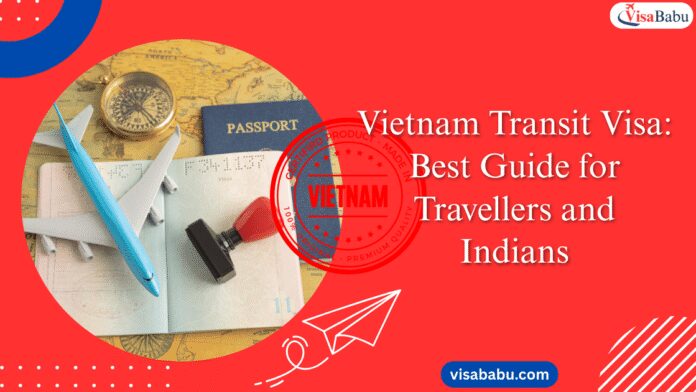Are you travelling somewhere which requires a change of plane in Vietnam or travelling to another destination that entails a layover in Vietnam? Understanding whether you need a Vietnam transit visa is crucial for a smooth journey. What you need to know about transit visas for Vietnam in 2025 – all that you need to know about requirements for Indian travellers, expenses, processes of application and Mr Expert’s hints to guarantee your trip goes on without a hitch.
Vietnam has just recently revised its visa policy to cater for more exciting international visitors. Vietnam now issues e-visas for citizens of 157 countries. This makes travel and entry as easy as never before, although there are certain rules that still exist depending on your nationality, layover duration, and the decision whether you are going to leave the airport or not.
What is a Vietnam Transit Visa?
A Vietnam transit visa is a short-term permit that allows travellers to pass through Vietnam while en route to another destination. Vietnam does not have a separate category of “transit visa,” unlike some of the countries that do present separate categories of transit visa. However, tourists willing to transit through Vietnam must apply for a tourist e-Visa or visa on arrival services.
You will need this permit when you are intending to get out of the airport’s transit area during your layover or if you will be staying longer than 24 hours. The visa is based on Vietnam’s Law no 47/2014 /QH13 that came into force 1st of January, 2015, which lays out the rules on foreigners’ entry and exit, entry within transit, and residency in Vietnam.
For most travellers, whether a transit visa is required boils down to two basic things. How much time will you spend in Vietnam, and if you will be leaving the transit zone in the airport or from a seaport?
Do I Need a Transit Visa for Vietnam?
Wondering, “do I need a transit visa for Vietnam”? The answer is subject to a variety of factors. Following the Immigration laws of Vietnam, you do not require a transit visa if all the following conditions are fulfilled:
- Your transit in Vietnam is less than 24 hours.
- You stay in the defined transit areas while on your layover
- You have a valid passport which has at least 6 months’ validity.
- Your ticket for further transport is confirmed.
- You possess a valid visa for your final destination (if required)
The transit areas are established by the management of international border gates. This translates to a transit area for air travellers in international airports. For cruise passengers, it is the international seaports where your ship is anchored.
For a stay of over 24 hours or if you are to leave the transit area, prepare to explore the city or to collect luggage for your next flight, you will have to get a visa. In such cases, you have to apply for a tourist visa for the period of your transit.
It is noteworthy that many airlines now specify transit regulations while booking in view of the lengthening layovers in Vietnamese airports. But if you are not sure about your particular case, it is recommended that you ask the airline in order to find out whether you are required to leave the transit area and come out to the transit airport to get your luggage.
Vietnam Transit Visa for Indian Citizens: Latest Expert’s Guide 2025
Indian passport holders have particular considerations when transiting Vietnam. Indians are also among the people who can travel to Vietnam without a Vietnam transit visa, provided they are in a layover of less than 24 hours, only at the airport’s transit area.
Latest Eligibility Criteria for Indian Travellers for Vietnam Transit Visa in 2025
Indian nationals transiting through Vietnam are required to meet the following requirements for them to do so without a visa:
- Possess a valid Indian passport that is 6 months valid.
- Possess a confirmed ticket indicating onward travel to the third country.
- Have a valid visa for the third country (if required)
- Remain in the specified transit area
- Have a layover that is of less than 24 hours.
If one of these conditions is not fulfilled – if you are, for example, going to leave the airport or if you have more than a 24-hour layover – you’ll need to obtain a visa. As Vietnam doesn’t provide transit visas on arrival to most nationalities, and Indians as well, you have to apply for a visa beforehand.
Latest Required Documents for Indian Applicants for Vietnam Transit Visa in 2025
Indian travellers applying for a Vietnam transit visa for indian citizens need to prepare the following documents:
- A legal Indian passport and at least 6 months’ validity
- Filled visa application form and signed it.
- Recent passport-sized photographs (4.5cm x 4.5cm, taken within the last 6 months)
- A confirmed ticket that will show you the way to the third country.
- Valid visa for your final destination (if required)
- Proof of sufficient funds for your stay (if requested)
In certain cases, there might be a need for additional supporting documents depending on your case. It is always better to make sure through the Vietnamese Embassy or consulate in India regarding the latest needs.
Vietnam Transit Visa Application Process in 2025
There are certain procedures for getting permission to transit through Vietnam, and these include obtaining it from the embassy, e-Visa and visa on arrival; these are the most popular ones.
How to Apply for a Vietnam Transit Visa Online (e-Visa) in 2025?
The e-visa choice is getting increasingly popular because of its convenience. Peculiar to August 15, 2025, Vietnam provides e-Visas to nationals of 157 countries, and this is a decent alternative for many foreigners. Here’s how to apply:
- Go to the Vietnamese Immigration official website.
- Fill up the online application form along with your personal and travel details.
- Post a recent picture and a scan of your data page on your passport.
- Pay the non-refundable application fee
- Make your application and wait for its processing.
- After being approved, you can download and print your e-Visa.
A Vietnam e-Visa normally has a processing time of 3-5 business days, which can take longer if there is a high volume of applications or if other circumstances delay the processing. The e-Visa covers stays of a maximum of 30 days, which is well beyond what is required for the sake of transit.
Vietnam Transit Visa on Arrival in 2025
For those who aren’t eligible for an e-Visa or prefer an alternative method, a Vietnam transit visa on arrival is another option. This process is carried out on the basis of acquiring a pre-approval letter before travelling to Vietnam. Here’s how it works:
- Seek an approval letter through a reputable agent online.
- Receive your approval letter via email (usually within 2-3 business days)
- Produce the approval letter and other documents needed to be produced.
- After alighting at a Vietnamese international airport, go to the visa counter.
- Upload your documents and stamping fee in cash.
- Get your visa stamp on your passport
The visa on arrival will only be available to air travellers who arrive through the international airports in Vietnam. The visa on arrival stamping fee is $25 and has to be paid in cash upon arrival.
Vietnam Transit Visa Cost and Processing Time in 2025
Understanding the Vietnam transit visa cost is essential for budget planning. This is a breakdown of the fees that are implied:
- E-Visa fee: Single entry: $25, Multiple entry: $50
- Visa on arrival stamping fee: $25 (to be paid in cash upon arrival)
- Service fee for approval letter: It depends on the policies of the agency
These costs are not refunded in any case, irrespective of the fact that the visa application was declined. To Indian tourists, the usual amount to pay is USD $25, which would be around ₹2,080 for the current exchange rate.
Processing times differ in relation to the method of application for the application method:
- E-Visa: 3-5 business days
- Letter of approval for visa on arrival. 2-3 business days
- Embassy application: 3-7 business days
Expedited services are offered for people who need their visa to be processed in a shorter period of time, but these require extra fees. For the latest information on the fees and processing time, feel free to get in touch with the Vietnamese embassy or consulate in your country.
Exemptions and Special Cases for Indians for Vietnam Transit Visa in 2025
There are some travellers who can be exempted from getting a Vietnam transit visa. These exemptions include:
- Nationals of countries that have visa-exempt agreements with the people of Vietnam.
- Travellers with layovers that are less than 24 hours and who stay in the transit area
- Travellers with valid diplomatic or official passports (depending on bilateral agreements)
- Travellers arriving in special economic zones or in coastal economic zones with particular rules.
It is worth mentioning that the policies of visa exemption may vary, so it is recommended to check the latest rules prior to the trip. The Vietnamese government sometimes makes changes to the visa policies in order to promote tourism and international relations.
Latest Guidelines on a Smooth Transit in Vietnam in 2025
To make a hassle-free transit through Vietnam, consider the following practical tips:
- Ask the airline about the procedures for baggage transfer. Some of the airlines do transfer the luggage automatically to your final destination, while others do require you to collect and re-check the bags.
- Try to allocate more time for the processing of visas if you need to do so. Last-minute applications may be stressful and will cost you more in the form of expedited service charges.
- Carry printed copies of all important documents, including your e-Visa, flight tickets, and hotel reservations (if applicable).
- Exchange some Vietnamese dong or US dollars for cash to be used in small payments or in case of extra charges.
- Learn the layout of the transit airport so that you can move conveniently between gates.
- If you are going to have a long layover and leave the airport, research transport beforehand.
Bear in mind that the immigration officers have the last word in granting permission to enter, so make sure that you have all the papers in order and are ready to explain your travel plans.
Common Mistakes to Avoid When Applying for a Vietnam Transit Visa in 2025
Quite a number of the travellers face problems with their applications for a Vietnam transit visa because of avoidable errors. The following are the common pitfalls to be avoided:
- Incomplete or incorrect application forms: Cross-check all the information before submitting your application.
- Insufficient passport validity: Make sure your passport is valid for at least 6 months after your estimated date of entry.
- Missing supporting documents: Prepare all necessary materials in advance, such as photos, tickets on a plane, visa to your last destination.
- Applying too late: Make your application as early as possible this taking care of the processing time and the possibility of delays.
- Not checking visa exemption eligibility: Check if you are exempt from a visa before applying for one.
- Overlooking transit area restrictions: Learn what the “transit area” is at the airport that you arrive at, and if you may have to leave it.
By shunning these common errors, you can save time, money, and avoid the extra stress that comes with the journey.
Conclusion
Navigating the requirements for a Vietnam transit visa doesn’t have to be complicated. By knowing when you will need a visa, how to apply for a visa, and what to prepare, your transit through Vietnam will be hassle-free.
Keep in mind that the main factors which will influence your necessity to obtain the transit visa are the duration of your layover and the way you are going to spend it – either leaving the airport or staying within its transit zone. You do not need a visa for layovers of less than 24 hours when you continue to stay in the transit area, i.e. most travellers-including Indians. For a longer stay or if you want to explore outside the airport, it is required to apply for an e-Visa or a visa on arrival.
With Vietnam’s growing visa policies more traveller-friendly, and also with eVisas available to the citizens of 157 countries, transiting through this beautiful country is easier than ever. Whether you are just passing through and looking at having a longer stopover to experience the culture of Vietnam and its breathtaking scenery, proper visa preparation will ensure your journey is smooth sailing.
FAQS( Frequently Asked Questions)
Q1. Do I need a transit visa for Vietnam if I have a layover of less than 24 hours?
Ans. No, you will not require a transit visa as long as you only have a layover for less than 24 hours and you don’t leave the designated transit area of the airport or the seaport.
Q2.Can Indian citizens get a Vietnam transit visa on arrival?
Ans. Yes, Indian citizens are allowed to get an on-arrival visa, but they must have a pre-approved letter before travelling to Vietnam.
Q3.What is the cost of a Vietnam transit visa for Indian nationals?
Ans. The standard fee is $25 (approximately ₹2,080) for a single-entry e-Visa, which is non-refundable even if the application is rejected.
Q4.How long does it take to process a Vietnam transit visa?
Ans. Otherwise, the processing of e-Visa applications is usually completed in 3-5 business days, though it may differ depending on the number of applications applied, incidental delays, and other factors.
Q5.What documents are required for a Vietnam transit visa?
Ans. Required documents include a valid passport with at least 6 months’ validity, a completed application form, recent passport-sized photographs, a confirmed onward ticket, and a visa for your next destination (if required)





